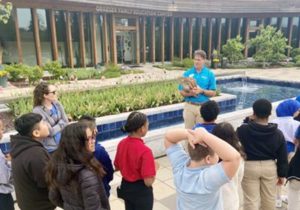 Cinnamon and chocolate sprinkles are unusual materials for a science lesson. But those sweet toppings help fourth graders from Slaughter Elementary learn how small creeks and streams can affect the quality of the Ohio River.
Cinnamon and chocolate sprinkles are unusual materials for a science lesson. But those sweet toppings help fourth graders from Slaughter Elementary learn how small creeks and streams can affect the quality of the Ohio River.
A 3-D tabletop model includes homes, farms and businesses and the small waterways that surround them. Toy cars, people and animals show students some of the things that negatively impact water quality.
“What kind of things might be on a farm that could get into a nearby stream?,” asks Louisville Water Supervisor of Event Operations Megan Jones, as she shakes chocolate sprinkles near miniature farm animals. An enthusiastic student knows the answer but looks extremely embarrassed to say it out loud. “It’s okay just say it, everybody poops,” exclaims Jones.
Spraying the model, she explains how rain moves common pollutants, like animal waste, into nearby waterways, eventually flowing into the Ohio River. Common pantry items like the chocolate sprinkles, cinnamon, and soy sauce replicate pet waste, chemicals, and oil.
The simulation is part of a multi-educational experience at the Waterfront Botanical Gardens. Jones along with Louisville Water Visitor Experience Specialists Lynn Humphrey and Jennifer Neal, teach the watershed lesson. The 60 students also go on a scavenger hunt identifying native plants in an outdoor garden. The final lesson emphasizes things students can do to protect the environment.
“Our partnership with the Botanical Gardens allows students to connect the dots. They learn that little things like tossing trash out of a window, have big impacts on the quality of our land, air and water,” said Channa Newman, Louisville Water Manager of Education and Outreach. She adds, “Joint educational efforts are a regular part of the company’s community outreach.” The Louisville Zoo, Frazier History Museum, and Kentucky Science Center are all longtime partners.

